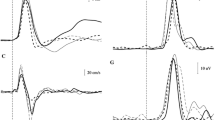Abstract
The purpose of this study was to examine the effect of prior experience concerning direction of a postural perturbation on the balance response of cats to translations of their support surface. Previous work has shown that, when cats are translated in many directions in the horizontal plane, they respond by exerting active forces with each paw in only two directions, termed the force constraint strategy. This study examined whether the force constraint strategy could be modified based on predictability of the direction of translation and whether this strategy is used by the naive animal with no prior experience of platform translation. Four cats were trained to stand quietly on the force platform using positive reinforcement, and then were implanted with chronically indwelling electrodes for recording electromyographic (EMG) activity. The first experiment concerned the response of the naive cats to their first exposure to platform translation and consisted of translations presented randomly in four different directions in the horizontal plane. The second experiment consisted of two complete sets of 16 directions of translation (15 trials per direction), with the direction of translation randomized in one set and serially ordered in the other, to make the direction of translation unpredictable or predictable, respectively. Forces exerted by the cat, EMG activity, and platform position were recorded during the 1-s trials. The use of the force constraint strategy was independent of prior experience with direction of translation, as was the amplitude of the response. Moreover, this strategy was observed in the naive cat. These findings suggest that the force constraint is a robust and consistent response to translational perturbations of stance in the cat and is part of its natural behavioral repertoire. The accuracy in specification of the direction of a postural response must be based on the sensory information that is obtained within a very short time after the onset of platform acceleration (loop time 40–70 ms). On the other hand, the amplitude of the postural response tended to decrease with experience and practice, suggesting a long-term change in central set that may manifest as a reduction in sensorimotor gain.
Similar content being viewed by others
References
Diener HC, Horak FB, Nashner LM (1988) Influence of stimulus parameters on human postural responses. J Neurophysiol 59:1888–1905
Diener HC, Horak F, Stelmach G, Guschlbauer L, Dichgans J (1991) Direction and amplitude precuing has no effect on automatic posture responses. Exp Brain Res 84:219–223
Dunbar DC, Macpherson JM (1993) Activity of neuromuscular compartments in lateral gastrocnemius evoked by postural corrections during stance. J Neurophysiol 70:2337–2349
Engberg I (1964) Reflexes to foot muscles in the cat. Acta Physiol Scand 62:1–64
Evarts EV, Tanji J (1974) Gating of motor cortex reflexes by prior instruction. Brain Res 71:479–494
Evarts EV, Shinoda Y, Wise SP (1984) Neurophysiological approaches to higher brain functions. Wiley, New York
Favilla M, Hening W, Ghez C (1989) Trajectory control in targeted force impulses VI. Independent specification of response amplitude and direction. Exp Brain Res 75:280–294
Ferrington DG (1985) Functional properties of slowly adapting mechanoreceptors in cat footpad skin. Somatosens Res 2:249–262
Hammond PH (1956) The influence of prior instruction to the subject on an apparently involuntary neuromuscular response. J Physiol 122:17–18
Holmquist B, Sandberg R (1991) The broken axis approach a new way to analyze bi-directional circular data. Experientia 47:845–851
Hongo T, Kudo N, Oguni E, Yoshida K (1990) Spatial patterns of reflex evoked by pressure stimulation of the foot pads in cats. J Physiol (Lond) 420:471–488
Horak FB, Diener HC, Nashner LM (1989) Influence of central set on human postural responses. J Neurophysiol 62:841–853
Hore J, Vilis T (1984) Loss of set in muscle responses to limb perturbations during cerebellar dysfunction. J Neurophysiol 51:1137–1148
Johansson RS, Westling G (1988) Coordinated isometric muscle commands adequately and erroneously programmed for the weight during lifting task with precision grip. Exp Brain Res 71:59–71
Macpherson JM (1988a) Strategies that simplify the control of quadrupedal stance. 1. Forces at the ground. J Neurophysiol 60:204–217
Macpherson JM (1988b) Strategies that simplify the control of quadrupedal stance. 2. Electromyographic activity. J Neurophysiol 60:218–231
Macpherson JM (1994) Changes in a postural strategy with interpaw distance. J Neurophysiol 71:931–940
Macpherson JM, Inglis JT (1993) Stance and balance following bilateral labyrinthectomy. In: Allum JHJ, Allum-Mecklenburg DJ, Harris FP, Probst R (eds) Natural and artificial control of hearing and balance. Elsevier Science, New York, pp 219–228
Macpherson JM, Lywood DW, van Eyken A (1987) A system for the analysis of posture and stance in quadrupeds. J Neurosci Methods 20:73–82
Mauritz KH, Wise SP (1986) Premotor cortex of the rhesus monkey — neuronal activity in anticipation of predictable environmental events. Exp Brain Res 61:229–244
Megaw ED (1972) Direction and extent uncertainty in step-input tracking. J Mot Behav 4:171–186
Mussa-Ivaldi FA, Hogan N, Bizzi E (1985) Neural, mechanical, and geometric factors subserving arm posture in humans. J Neurosci 5:2732–2743
Prochazka A (1989) Sensorimotor gain control: a basic strategy of motor systems? Prog Neurobiol 33:281–307
Riehle A, Requin J (1989) Monkey primary motor and premotor cortex: single-cell activity related to prior information about direction and extent of an intended movement. J Neurophysiol 61:534–549
Vicario DS, Ghez C (1984) The control of rapid limb movement in the cat. IV. Updating of ongoing isometric responses. Exp Brain Res 55:134–144
Author information
Authors and Affiliations
Rights and permissions
About this article
Cite this article
Macpherson, J.M. The force constraint strategy for stance is independent of prior experience. Exp Brain Res 101, 397–405 (1994). https://doi.org/10.1007/BF00227333
Received:
Accepted:
Issue Date:
DOI: https://doi.org/10.1007/BF00227333




